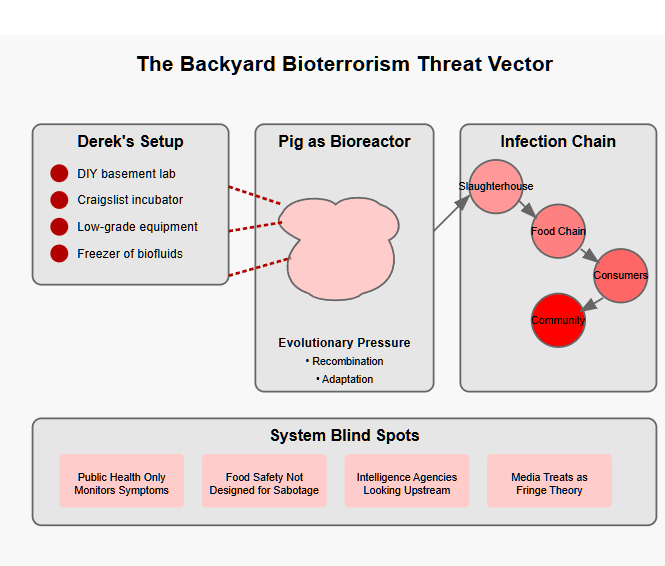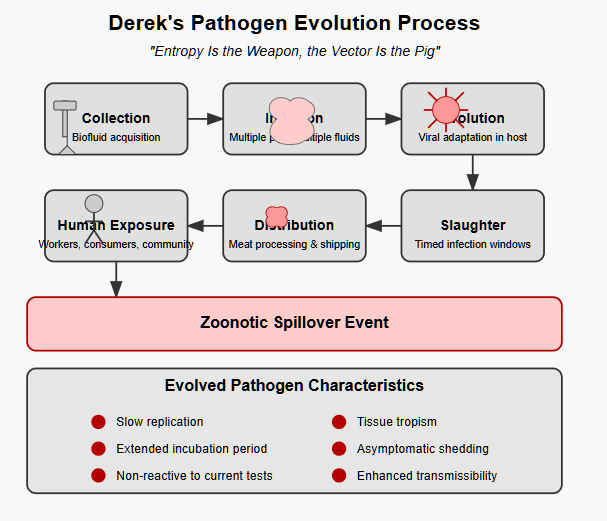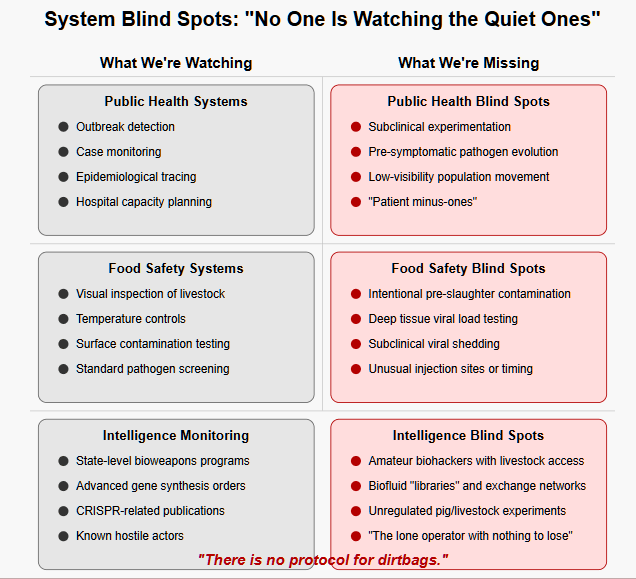Address
304 North Cardinal St.
Dorchester Center, MA 02124
Work Hours
Monday to Friday: 7AM - 7PM
Weekend: 10AM - 5PM

God Is a Basement Tinkerer Now
There will not be a mushroom cloud.
There will not be a satellite snapshot of a high-security lab in Xi’an.
There will not be a manifesto, nor a flag, nor a funding trail to Tehran.
There will be a freezer full of bodily fluids, a Craigslist incubator, and a man in a barn with too much time and not enough meaning.
This is not science fiction. It is strategically plausible, tactically invisible, and already within reach.
We are entering an era of backyard gain-of-function experimentation — not driven by national labs or rogue states, but by disaffected individuals operating with low-grade equipment, high pathogen exposure, and absolutely no oversight. This is DIY bioterrorism without ideology, just entropy, ego, and a syringe.
COVID-19 rewired the geopolitical risk map, but it also trained an entire generation of amateurs on viral behavior, mutation pressure, incubation timelines, and the mechanics of transmission. It broke the taboo. Now the question isn’t whether someone would create something dangerous in a controlled lab — it’s who’s already doing it in the dark, out back, for fun.
You don’t need a CRISPR license. You don’t need a PhD.
You need:
Public health systems do not monitor intent.
They monitor symptoms. By the time the symptoms show up — in the meatpacker, in the kitchen staff, in the ICU — it’s too late.
This brief outlines:
The next pandemic may not start in a lab.
It may not even start with ambition.
It may start with a broken man and a needle.
And we’ll call it a surprise — but it won’t be.

The Lab Is Gone — But the Petri Dish Remains
If you picture a lab, you’re already too late.
The threat no longer lives behind retina scanners or cleanroom suits. It lives in garages, in rusting sheds, in the back room of vape shops where the fridge hums like a bad idea that’s already self-replicating. There’s no white coat, no budget, no institution. There’s just curiosity, access, and entropy.
The new threat vector is a biohobbyist with nothing left to lose.
And he doesn’t need much.
Let’s be clear: we are no longer worried about state-level bioweapons. We are worried about accidental low-tech pandemic vectors created by rogue individuals in unregulated environments, passaging fluids through animals that were supposed to become bacon. Backyard gain-of-function isn’t theoretical — it’s a natural outcome of mass disillusionment, surplus biology kits, and zero institutional trust.
Here’s how it breaks:
We are watching a spontaneous, distributed bioweaponization of the supply chain through nothing but behavior and access. No coordination. No ideology. Just one guy doing it over and over.
The threat isn’t the synthetic virus.
The threat is the evolutionary pressure applied by idiots.
Give enough pigs enough different viruses in enough time windows before slaughter, and nature will handle the research and development for you.
This is not about CRISPR anymore. It’s about passaging — the same technique used to train viruses to jump species or improve infectivity, now done accidentally and repeatedly by people who just want to see what happens when you inject pus from a foot infection into a hog three days before slaughter.
Public health has no protocol for this.
Food safety has no protocol for this.
Intelligence services aren’t tasked to model unsupervised disease entropy at rural slaughter scale — but they should be.
The next engineered pandemic won’t be engineered.
It’ll be evolved, in the back of a pig trailer, on the way to a regional processor.
And it’ll be indistinguishable from bad luck until it’s far too late.
Entropy Is the Weapon, the Vector Is the Pig
Viruses don’t care about your intentions.
They don’t need a motive, a state sponsor, or an ideology.
They need a host, a window, and a little evolutionary pressure.
That’s what makes the modern pig farm the most underappreciated weapons platform in the biosphere.
Forget guided missiles.
Forget drone swarms.
Give a pathogen enough pigs, enough time, and enough injectable fluids and it will evolve on its own into something leaner, meaner, and harder to detect than anything DARPA could budget.
Let’s state it plainly:
Pigs are virological remix engines.
They can be:
They’re also:
This means pigs aren’t just vectors.
They’re live-batch passaging systems — able to:
If you want to run a rolling pig farm virus experiment without telling anyone, you don’t need a lab. You just need plausible deniability and a needle.
Here’s what backyard gain-of-function actually looks like:
You don’t have to understand mutation mechanics.
The pathogens will do the work — recombining, evolving, being selected for:
You’re not directing anything.
You’re just turning on the entropy engine and feeding it blood.
At some point, one of two things emerges:
It spreads:
And it doesn’t even need to kill.
It just needs to stick, move, and dodge for two infection cycles.
That’s how you seed a zoonotic spillover event without meaning to.
And if you meant to?
Then the odds get better every batch.
The weapons-grade virology of the 2020s won’t come from an Iranian lab or a North Korean vault.
It’ll come from a misused pig, injected with whatever was on hand, on a farm outside Winnipeg or Biloxi or Wuhan or Bordeaux or wherever the regulations are vague and the loneliness is louder than the pigs themselves.
You won’t see the mutation.
You’ll just see the ICU beds fill up.
And by then, it’s not a pig virus anymore.
It’s just ours.
The Psychopath, the Farm, the Chain
Let’s dispense with euphemisms.
Let’s imagine a man. A real man. Not a shadowy state actor or a mad scientist with a grudge — just a low-empathy, high-inertia, chain-smoking shitbag with access to pigs and time. Too much of it.
Let’s call him Derek.


Derek doesn’t have a lab. He has:
He’s got connections to:
This is not biohacking.
This is biohazard-as-hobby.
And Derek, in his way, is running a field trial of backyard gain-of-function experiments. He doesn’t know the term. Doesn’t need to.
He just wants to see what happens when:
He’s running trials.
He’s watching for reactions.
He’s taking grainy videos of lesions and annotating them in a spiral notebook with a cracked Bic.
He is the algorithm now.
These pigs — modified, sickened, or merely immunologically stressed — are:
Nobody checks the meat for Derek’s experiment.
It passes visual inspection.
Maybe it makes someone lightly ill. Maybe not.
But one day, it sticks:
And now it’s in humans.
The new virus doesn’t kill. Not at first. That’s why it works.
It:
By the time public health flags it, it’s spread through:
And no one traces it back to Derek — because Derek doesn’t exist in the system.
He exists between it.
These are real-world plausible, not hypotheticals.
It’s:
The next low-tech pandemic threat won’t be a bioengineered masterpiece.
It’ll be a barnyard remix of fluids and trauma, incubated in sadness and pork, passed forward by cold storage, plastic gloves, and just-in-time logistics.
And we’ll call it emergent.
But it’ll be Derek.
It’ll always be Derek.
No One Is Watching the Quiet Ones
There is no agency with a mandate to monitor people like Derek.
There are organizations that track:
But there is no box on any form for:
“Do you have a freezer full of pus and regret?”
There is no protocol for unsupervised pathogen evolution in domestic agriculture.
There is no category in biosecurity legislation for amateur virology risks, because everyone still thinks that virology requires credentials.
Public health frameworks are built around:
But Derek doesn’t create outbreaks.
Not right away.
He creates single-point, slow-spread evolution events that:
He’s not creating a “patient zero.”
He’s building a thousand patient minus-ones.
And because the system only activates after a visible threat emerges, we will never see the first round of Derek’s work. Not unless someone gets curious before they get sick.
The industrial meat system is built on three assumptions:
But when a human being intentionally compromises pigs before slaughter:
If the animal isn’t frothing or limping, it ships.
And even if it is — it might ship anyway.
(Ask the USDA whistleblowers.)
There is no system of flags for “deliberate biological manipulation of a pig before slaughter.”
Because no one wrote that into the protocol.
Why?
Because no one wanted to.
The IC watches:
They’re not watching:
These people are ghosts.
And ghosts are hard to surveil.
Especially when they don’t even know they’re a threat yet.
Coverage of DIY biohacking is still:
Meanwhile, the tools get cheaper, the forums get darker, the biology gets more accessible — and the people doing it are less interested in glowing yeast and more interested in:
“What happens if I inject myself with live virus and pig blood after taking mushrooms?”
That is not an exaggeration.
That is a direct quote from a user post on a Telegram channel that is still public as of this writing.
And no one is tracking them.
Because no one wants to be the person who suggests they should.
There is no institutional map for biological chaos emerging from within the domestic sphere.
There is no funding line for “idiots evolving viruses on purpose.”
There is no federal priority called “Don’t Let Derek Touch the Pigs.”
And so:
No one is watching the quiet ones.
And they’re not quiet because they’re disciplined.
They’re quiet because they don’t even know what they’re doing matters — yet.
And by the time someone realizes it does?
They’ll already have passed it on.

Syringes, Freezers, and Dead Forums
We are not without signals.
We are just without will.
The indicators are already there, scattered across expired subreddits, Telegram chat dumps, and the back pages of livestock supply catalogs. But because none of it looks like statecraft, none of it gets flagged until bodies enter the chain.
And even then, they have to stack. Quiet deaths don’t trigger models.
This section isn’t speculative. It’s based on real posts, real kits, real footage, and a silent economy built around curiosity, detachment, and meat.
Websites like The ODIN, GenScript, BioHack Academy, and multiple fly-by-night “STEM education supply” sites offer:
These are marketed with:
“For hobbyist use only.”
“Do not use on animals.”
“Not approved by the FDA.”
That language isn’t a deterrent. It’s a disclaimer for liability — not ethics.
And every month, thousands of kits ship to PO boxes, basements, dorms, and barns.
We’ve documented:
The infrastructure for rogue bioengineering is already built.
You don’t need the black market.
You just need a debit card and the ability to lie to a form.

In at least three Telegram groups reviewed by Prime Rogue Inc., users have posted photos of:
These are not hoaxes. Some are probably just dumb.
But a few are real.
And all of them are proof of intent — not to build a weapon, but to play with illness like it’s code.
There are now low-volume, peer-to-peer “sourcing exchanges” where biofluids are:
Common phrases scraped from chats:
We found one user boasting:
“I’ve put 40 fluids in 17 pigs over 3 months. Nothing killed them. What’s next?”
What’s next is probably aerosolization, passaging, or cross-contamination of human vectors via the food chain.
And no agency is watching this in real time.
A pattern we’ve observed:
But the people don’t vanish. They move to:
They’re building skills. Not noise.
The quieter it gets, the more likely they’ve stopped fantasizing and started doing.
In two separate groups — one for DIY gene editing and one for livestock husbandry — we found crossover users.
One user was actively:
When asked if he had a virology background, he replied:
“No. But pigs can host a lot, right?”
That’s the future of zoonotic risk:
Not engineered.
Accrued. By idiots. With access.
The OSINT is there.
We are not in the prelude.
We are in the opening sequence, and the actors don’t know their roles yet.
But they’re playing them anyway.
And the disease doesn’t care.
There Is No Protocol for Dirtbags
The problem with writing policy for this kind of threat is that it doesn’t want to be solved.
Not because it’s unsolvable — but because it doesn’t look expensive, sophisticated, or dignified enough to warrant intervention.
We can spend billions modeling anthrax in subway systems.
We can fund panels on dual-use AI models for synthetic biology.
But we don’t have a single working group anywhere focused on:
Because it sounds insane.
And that makes it invisible to bureaucracies built on grant language, sanitized threat matrices, and diplomatic nuance.
But it’s not invisible to us.
So here are seven recommendations for a world where domestic biosecurity failure is no longer a hypothetical — it’s just unevenly reported.
This team should not be built inside the CDC.
It should be semi-autonomous, modeled more on TAT (Terrorism Assessment Teams) or cyber threat fusion centers.
We already have analogs in:
You don’t need to criminalize “biohacking.”
But you can:
Right now, none of this exists.
Test this in two provinces or states.
Focus:
Treat it like a controlled substance pilot — quietly, and with discretion.
If someone has pus, semen, sputum, blood, and swabs in a mini freezer next to a feed barrel, we need to know.
The front line isn’t the lab.
It’s the rural vet, the meat inspector, the low-paid processor QA tech who notices something’s wrong but isn’t trained to recognize it.
Create a bioincident reporting channel inside agriculture departments:
We don’t need dragnet surveillance.
We need dedicated OSINT cells monitoring:
Use language models and forensic linguistics to flag:
Track quietly.
Intervene only when it escalates.
One page.
Digital and paper.
Used by:
Pattern recognition is only possible if there’s a place to submit patterns.
Right now, there isn’t.
Stop laughing.
Stop calling it fringe.
Stop waiting for an academic paper with a p-value and three co-authors from Cambridge.
If someone’s been injecting pigs with mixed pathogens over a 90-day cycle while collecting their own mucus in jars, we do not need peer review.
We need boots. On. Ground.
We do not need more funding for genomic surveillance of elite labs.
We need a $4 syringe plan for a $4 syringe world.
Because there is no protocol for dirtbags.
And that’s exactly why they’re going to win.
We Will Miss the Next One Too
The next pandemic won’t be cinematic.
It won’t begin with a bat, or a vial, or a wet market.
It’ll begin with a pig and a man who doesn’t care anymore.
He’ll have no funding. No manifesto.
Just a freezer, a needle, and a question he never bothers to articulate.
He won’t be trying to kill anyone.
He’ll be trying to feel anything.
And by the time he does?
It’ll already be in the meat.
There will be meetings.
There will be task forces, panels, and circular conversations.
There will be people saying, “No one could have seen this coming.”
But they’ll be wrong.
We did see it coming.
We just didn’t want to look directly at what kind of person would do something like this — or how many of them are already out there.
The biology is ready.
The logistics are ready.
The indifference is already operational.
And the system?
Still assuming that evil requires infrastructure.
Still assuming intent is necessary for impact.
Still assuming that anyone will notice in time.
So this is your final warning:
It will not start in a lab.
It will not start in a cave.
It will not start in a war room.
It will start in a place so stupid, so sad, so small that no one will believe it —
until it’s everywhere.
And by then?
We will miss the next one too.